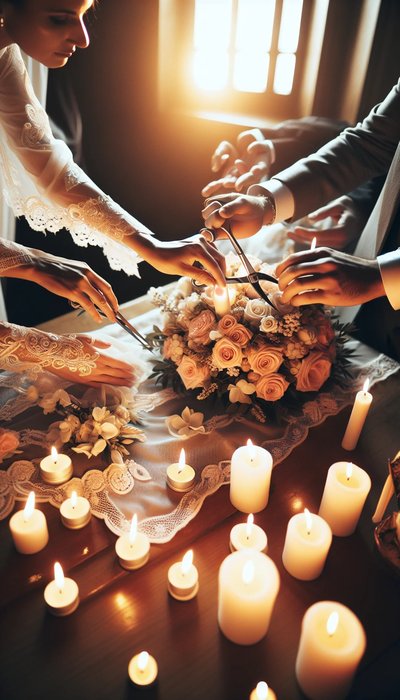Georgia Wedding Traditions Cultural Wedding Guide 2025
Georgian wedding traditions are elaborate multi-day celebrations combining Orthodox Christian ceremonies, ancient regional customs, and legendary hospitality that typically involve 200-500 guests and cost between $15,000-$50,000 USD. These traditions encompass pre-wedding matchmaking (machanklobamats-khan-klo-ba), engagement ceremonies (nishnobanish-no-ba), civil and religious ceremonies, elaborate feast celebrations (suprasup-ra) with ceremonial toasts led by a toastmaster (tamadata-ma-da), traditional dances, and post-wedding customs, creating celebrations that typically last 12-24 hours and reflect Georgia’s 3,000-year [cultural heritage](https://ich.une.

Overview of Georgian Wedding Process & Timeline

- 12-6 months before: Machanklobamats-khan-klo-bamatchmaking and family introductions
- 6-3 months before: Nishnobanish-no-baengagement ceremony with 50-100 guests
- 1 month before: Pre-wedding family gatherings and preparations
- Wedding day: Civil ceremony, religious ceremony, procession, and suprasup-ra feast
- Day after: Namtsetsobanam-tsets-o-baleftovers day with close family
- First month: Visits to relatives who couldn’t attend
What Are Georgian Pre-Wedding Traditions?

Georgian pre-wedding traditions include formal matchmaking ceremonies and elaborate engagement celebrations that establish bonds between families 3-12 months before the wedding. These customs cost $500-$3,000 USD and involve 20-100 participants depending on family size and regional practices.
Machankloba: Georgian Matchmaking Tradition
Machanklobamats-khan-klo-baka_mats-khan-klo-ba is the Georgian matchmaking tradition that initiates the wedding process through formal family meetings and investigations lasting 1-3 months. This centuries-old practice involves trusted family members and friends who facilitate introductions between prospective couples and their families, traditionally requiring 3-5 formal meetings before proceeding to engagement.
Historical matchmaking process:
- Family elders investigated potential in-laws’ reputation and social standing
- Matchmakers served as official intermediaries between families
- Formal approval required from both patriarchs before proceeding
- Process typically took 2-6 months in traditional communities
Modern matchmaking adaptations:
- 75% of urban Georgian couples now choose partners independently
- Family approval remains important for 90% of couples
- Matchmaking evolved into pre-celebration family meetings
- Average modern process takes 1-2 months
Nishnoba: Georgian Engagement Ceremony
Nishnobanish-no-baka_nish-no-ba is the formal Georgian engagement ceremony marking the second stage of wedding preparations with gift exchanges, feast celebrations, and official family agreements. This celebration typically costs $1,000-$5,000 USD, involves 50-150 guests, and takes place 3-6 months before the wedding.
Traditional engagement gifts include:
- For the bride: Gold wedding ring ($500-$2,000), perfumes, expensive wine, cognac, chocolates
- For the groom: Gold bracelet or chain ($300-$1,500) presented during the feast
- Between families: Traditional foods, homemade wine, ceremonial breads
Regional engagement variations:
- Kakheti region: Features special wine ceremonies with 10-15 varieties
- Svaneti mountains: Includes traditional music performances lasting 2-3 hours
- Adjara coast: Incorporates distinctive pre-wedding rituals unique to the region
- Tbilisi urban: Often held in restaurants costing $50-$100 per guest
Pre-Wedding Family Gatherings
Georgian pre-wedding gatherings are intimate family meetings occurring 1-4 weeks before the wedding where 20-50 relatives discuss wedding preparations, share marriage advice, and strengthen inter-family bonds. These gatherings cost $200-$1,000 each and typically involve preparing traditional foods together.
Common pre-wedding activities:
- Bride preparation sessions: Female relatives gather for 4-6 hours
- Traditional food preparation: Making churchkhelachurch-khe-la, preparing khachapurikha-cha-pu-ri
- Wine selection: In Kakheti, families taste 15-20 varieties
- Dance rehearsals: Learning traditional wedding dances over 2-3 sessions
Georgian Wedding Ceremony Types & Requirements

Georgian law requires couples to complete a civil ceremony for legal recognition, followed by optional religious ceremonies that 85% of couples choose to include. The combined ceremonies typically cost $500-$2,000 USD and involve 50-200 guests.
Civil Marriage Requirements in Georgia
Georgian civil marriage is a mandatory legal procedure taking 30-60 minutes at Houses of Justice or Houses of Marriage, costing 100-200 GEL ($35-70 USD). This simple process requires only valid passports and two witnesses, with ceremonies available in all major Georgian cities including Tbilisi, Batumi, Kutaisi, and Rustavi.
Civil ceremony locations and costs:
- House of Justice: 100 GEL ($35 USD), available in 15 cities
- House of Marriage: 150-200 GEL ($50-70 USD), more ceremonial setting
- Express service: 300 GEL ($105 USD), same-day registration
- Weekend ceremonies: Additional 50 GEL ($17 USD)
Georgian Orthodox Wedding Ceremonies
Georgian Orthodox wedding ceremonies are religious celebrations lasting 45-90 minutes where couples exchange rings, receive ceremonial crowns, and circle the altar three times symbolizing the Holy Trinity. These ceremonies, conducted in 80% of Georgian weddings, cost $200-$1,000 USD including church donations and typically involve 100-300 guests.
Key Orthodox ceremony elements:
- Ring exchange: Blessed rings symbolizing eternal commitment
- Crown ceremony: Ornate crowns representing God’s blessing
- Triple circling: Walking around altar symbolizing eternal journey
- Wine sharing: Drinking from common cup representing shared life
Regional religious variations:
- Western Georgia: 90% Orthodox ceremonies with regional hymns
- Adjara region: 30% Muslim ceremonies reflecting historical influences
- Tbilisi: Mixed ceremonies accommodating diverse populations
- Mountain regions: Traditional Orthodox with ancient local customs
Georgian Wedding Procession Traditions

Georgian wedding processions are jubilant street celebrations where the wedding party travels through neighborhoods in decorated vehicles, announcing the marriage to the community with horn honking and music. Modern processions involve 10-50 cars, cost $500-$2,000 for decorations and fuel, and can extend 5-20 kilometers through city streets.
Traditional procession elements:
- Lead vehicle: Bride and groom in decorated car or limousine
- Following cars: 20-50 vehicles with family and friends
- Music: Traditional Georgian songs played loudly
- Duration: 30-90 minutes depending on route
- Community participation: Neighbors offer congratulations from balconies
Modern procession adaptations:
- Decorated luxury vehicles costing $200-$500 per car
- Professional videographers capturing aerial footage
- Police escorts for processions over 30 cars
- GPS-coordinated routes avoiding traffic
Makrioni: Georgian Wedding Witnesses
Makrionimak-ri-o-nika_mak-ri-o-ni are the official wedding witnesses in Georgian tradition who accompany the couple throughout the wedding day, from morning preparations through the final feast celebrations. These trusted friends, similar to best man and maid of honor roles, contribute $500-$2,000 toward wedding expenses and participate in all ceremonies.
Makrioni responsibilities include:
- Morning pickup of bride from family home
- Participating in plate-breaking ceremony
- Standing with couple during religious ceremony
- Leading certain dances at reception
- Assisting with gift collection and organization
Georgian Wedding Attire & Fashion
Georgian wedding attire combines traditional national dress with modern fashion, with grooms increasingly choosing the traditional chokhacho-khacosting $500-$2,000 while 70% of brides opt for Western-style white gowns ($1,000-$5,000). Regional variations in traditional dress reflect local cultural heritage and can increase costs by 30-50%.
Traditional Georgian Wedding Clothing
Chokha (ka_cho-kha) is the traditional Georgian men’s wedding garment, a fitted wool coat featuring decorative cartridge cases (masrimas-ri) across the chest, costing $500-$3,000 depending on quality and ornamentation. This national costume, worn by 40% of Georgian grooms, symbolizes masculinity, warrior tradition, and cultural pride.
Regional dress variations:
- Kartli style: Black chokha with silver accessories ($800-$1,500)
- Kakheti style: Dark blue with regional embroidery ($600-$1,200)
- Mountain regions: Heavier wool with fur elements ($1,000-$2,000)
- Adjara style: Distinctive decorative patterns ($700-$1,400)
Modern Bridal Fashion in Georgia
Contemporary Georgian brides typically invest $1,500-$5,000 USD in Western-style wedding dresses, with 30% incorporating traditional Georgian elements like regional jewelry or embroidered veils. Tbilisi’s wedding fashion industry has grown 200% since 2015, offering both international designer gowns and Georgian-European fusion designs.
Georgian Plate-Breaking Ceremony
The Georgian plate-breaking tradition is a symbolic ritual performed by newlyweds at the reception venue entrance, representing the breaking of old lives and beginning of their union. This 5-minute ceremony, witnessed by all 200-500 guests, requires a special decorative plate ($20-$50) and is believed to bring prosperity and ward off evil spirits.
Plate-breaking ceremony details:
- Timing: Immediately upon arrival at reception venue
- Participants: Bride, groom, and makrionimak-ri-o-ni
- Symbolism: Breaking with past, ensuring good fortune
- Modern adaptations: Some use specially crafted artistic plates
- Photography moment: Key photo opportunity for all guests
Supra: The Georgian Wedding Feast
Georgian wedding suprasup-ra is an elaborate 6-12 hour feast featuring 15-20 courses, unlimited wine, ceremonial toasts, and traditional entertainment, costing $50-$150 per guest for 200-500 attendees. This pinnacle of Georgian hospitality traditionally continues until dawn, with some celebrations extending into the following afternoon.
Understanding Georgian Supra Traditions
Supra (ka_sup-ra) represents Georgian hospitality through structured feasting that dates back over 1,000 years, originally developed for religious holidays and evolved into the centerpiece of wedding celebrations. Wedding supras follow specific protocols including toast order, serving sequences, and guest hierarchies that reflect social relationships and cultural values.
Traditional supra components:
- Duration: 6-12 hours minimum, some lasting 24 hours
- Courses: 15-20 dishes served in specific order
- Wine consumption: 2-3 liters per guest average
- Toasts: 20-30 formal toasts throughout evening
- Entertainment: Live music, dancing, performances
Regional Supra Variations
Regional differences in Georgian wedding supras reflect local culinary traditions and available ingredients, with costs varying from $30-$200 per guest depending on location and menu selections.
| Region | Specialty Dishes | Wine Focus | Cost per Guest | Duration |
|---|---|---|---|---|
| Kakheti | Mtsvadimts-va-di, Chakapulicha-ka-pu-li | 15-20 local varieties | $50-$100 | 8-12 hours |
| Adjara | Acharian khachapurikha-cha-pu-ri, seafood | Imported + local | $60-$120 | 6-10 hours |
| Svaneti | Kubdarikub-da-ri, Tashmijabitash-mi-ja-bi | Limited varieties | $40-$80 | 10-15 hours |
| Tbilisi | Mixed regional dishes | Premium selections | $80-$200 | 6-12 hours |
Tamada: The Georgian Toastmaster
Tamadata-ma-daka_ta-ma-da is the Georgian toastmaster who orchestrates the entire wedding feast through eloquent toasts, controlling the flow of wine and maintaining celebration energy for 6-12 hours. Professional tamadas charge $500-$2,000 for weddings, while family tamadas receive gifts worth $200-$500 in appreciation.
Role of the Wedding Tamada
The tamada sits at the head table with the Merikipeme-ri-ki-peka_me-ri-ki-pe or wine pourer, who ensures the tamada’s glass remains full throughout the celebration. This partnership maintains the feast’s rhythm through coordinated service and timing.
Tamada responsibilities include:
- Opening toast: 5-10 minute speech blessing the couple
- Toast sequence: Managing 20-30 toasts in traditional order
- Alaverdia-la-ver-di: Passing speaking opportunities to guests
- Timing control: Balancing speeches, eating, and dancing
- Energy maintenance: Keeping celebration lively for 6-12 hours
Traditional toast sequence:
- To the newlyweds’ union (10-15 minutes)
- To parents and family (5-10 minutes each side)
- To children yet to come (5 minutes)
- To deceased relatives (moment of silence)
- To friendship (5-10 minutes)
- To love (5-10 minutes)
- To the homeland (5 minutes)
Traditional Georgian Wedding Dances
Georgian wedding dances are performed throughout the reception, with professional dancers often hired for $500-$1,500 to perform complex choreographies while guests participate in simpler traditional dances. These performances, lasting 3-5 minutes each, punctuate the feast at specific moments determined by the tamadata-ma-da.
Kartuli: The Georgian Wedding Dance
Kartulikar-tu-lika_kar-tu-li is the quintessential Georgian romantic dance performed by couples at weddings, characterized by maintained distance between partners and the man’s motionless upper body while executing complex footwork. This 5-7 minute performance, requiring years of training, symbolizes respectful courtship and idealized love in Georgian culture.
Kartuli performance elements:
- Distance maintained: 1-2 meters between partners
- Eye contact: Woman keeps eyes lowered until final moments
- Male technique: Upper body completely still, intricate footwork
- Female technique: Gliding movements, graceful arm positions
- Musical tempo: Slow 3/4 time, building to climax
Acharuli: Adjarian Celebration Dance
Acharulia-cha-ru-lika_a-cha-ru-li is a playful flirtation dance from Georgia’s Adjara region, performed by 6-16 dancers in bright red costumes at wedding celebrations. This 8-10 minute energetic dance costs $200-$400 to hire professional performers and brings youthful energy to the middle portion of wedding receptions.
Khorumi: Georgian War Dance at Weddings
Khorumikho-ru-mika_kho-ru-mi is an ancient Georgian war dance performed by 31-41 dancers (always odd numbers) at weddings to demonstrate strength and tradition. Despite its martial origins depicting battle preparation and victory, this 10-15 minute performance has become a wedding staple, costing $500-$1,000 for professional troupes.
Georgian Wine Traditions at Weddings
Georgian wedding wine traditions reflect the country’s 8,000-year winemaking history, with couples serving 10-30 varieties throughout the celebration at a cost of $2,000-$10,000 for quality selections. Wine consumption averages 2-3 liters per guest, with specific vessels and rituals for each type of toast.
Wine Service Protocols
Traditional wine service at Georgian weddings follows strict protocols, with red wines for major toasts, white wines for lighter moments, and special qvevrikve-vri wines for honoring parents. The average wedding requires 200-400 liters of wine for 200-300 guests.
Wine selection by region:
- Kakheti weddings: 70% local varieties, featuring Saperavisa-pe-ra-vi, Rkatsitelirka-tsi-te-li
- Imereti weddings: Focus on Tsitskatsits-ka, Tsolikouritso-li-kou-ri whites
- Kartli weddings: Chinurichi-nu-ri, Goruli Mtsvanego-ru-li mts-va-ne specialties
- Urban weddings: Mixed regional selections plus imports
Shared Cup Ceremony
The shared wine cup ceremony involves newlyweds drinking from a special silver or horn vessel (kantsikan-tsi) worth $100-$500, symbolizing their united future. This 5-minute ritual occurs during the religious ceremony or early in the suprasup-ra, with the cup becoming a family heirloom.
Modern Georgian Bride Kidnapping Traditions
Symbolic bride abduction (ka_sa-tsole-gat-atsva) in modern Georgia is a consensual tradition where couples elope to avoid wedding expenses, saving $10,000-$30,000 compared to traditional celebrations. This practice, occurring in 5-10% of Georgian marriages, requires full consent from the bride and both families.
Modern “kidnapping” scenarios:
- Cost-saving elopement: Couple marries quietly, announces later
- Symbolic ritual: Brief “abduction” before returning for reception
- Family drama avoidance: When families have conflicts
- Student marriages: Young couples avoiding expense
Legal requirements remain:
- Civil ceremony still mandatory
- Parental consent for those under 18
- Two witnesses required
- Registration within 30 days
Post-Wedding Georgian Customs
Georgian post-wedding traditions extend the celebration beyond the main event, with customs designed to solidify family bonds and honor those who couldn’t attend the primary celebration.
Namtsetsoba: The Leftovers Day
Namtsetsobanam-tsets-o-baka_nam-tsets-o-ba is the Georgian “leftovers day” held 12-24 hours after the main wedding where 30-50 close family members gather to eat remaining food and discuss the celebration. This intimate gathering, lasting 4-6 hours, costs nothing additional and allows families to bond without the formality of the main event.
Namtsetsoba traditions include:
- Informal atmosphere: No tamadata-ma-da or formal toasts required
- Gift opening: Couple opens presents with family
- Story sharing: Guests share funny moments from wedding
- Planning discussions: Future family gatherings planned
- Leftover distribution: Food divided among family members
Newlywed Visiting Customs
Traditional newlywed visits occur during the first month of marriage, with couples visiting 10-20 relatives who couldn’t attend the wedding, receiving additional gifts worth $50-$200 per household. These visits, lasting 2-3 hours each, strengthen extended family bonds and share wedding photos and stories.
Regional Georgian Wedding Variations
Georgian wedding traditions vary significantly across regions, with each area maintaining distinctive customs that reflect local history, geography, and cultural influences over centuries.
Mountain Region Weddings (Svaneti, Khevsureti)
Mountain region weddings in Svaneti and Khevsureti feature 3-5 day celebrations with 500-1,000 participants from entire villages, costing $20,000-$40,000 total. These remote area weddings maintain ancient traditions including ceremonial horseback arrivals and community-wide feast preparations.
Distinctive mountain traditions:
- Duration: 3-5 days minimum, entire village participates
- Ceremonial clothing: Unique regional costumes worth $1,000-$3,000
- Traditional weapons: Ceremonial daggers and swords displayed
- Community feast: Every household contributes dishes
- Ancient dances: Preserved choreographies unseen elsewhere
Wine Region Weddings (Kakheti)
Kakhetian weddings center around wine culture with specialized rituals including blessing of the vineyard, tasting ceremonies featuring 20-30 varieties, and gifts of family qvevrikve-vri wine aged 5-20 years. These celebrations cost 30% more than average due to premium wine service.
Kakheti wine wedding elements:
- Pre-wedding wine blessing: Priest blesses family vineyard
- Tasting ceremonies: 3-hour structured tastings for guests
- Qvevri opening: Ceremonial opening of buried wine vessels
- Wine gifts: Each family receives bottles from family reserve
- Harvest wedding timing: 60% occur during September harvest
Coastal Region Weddings (Adjara)
Adjarian coastal weddings blend Georgian traditions with Turkish and maritime influences, featuring seafood-centric menus costing $80-$150 per guest and distinctive musical styles using the chibonichi-bo-ni and dolido-li instruments. These celebrations accommodate both Christian and Muslim traditions, reflecting the region’s diverse heritage.
Urban Tbilisi Weddings
Tbilisi weddings represent Georgia’s most cosmopolitan celebrations, blending traditional elements with international trends at venues costing $5,000-$20,000 for rental alone. Urban couples spend an average of $30,000-$80,000 total, incorporating elements from various regional traditions while adding contemporary touches.
Urban wedding trends:
- Venue variety: Hotels, restaurants, wineries, museums
- Guest management: Digital invitations, seating apps
- Entertainment: DJs alongside traditional musicians
- Menu fusion: Georgian classics with international options
- Photography: Drone footage, same-day edits standard
Modern Adaptations of Georgian Wedding Traditions
Contemporary Georgian couples are reimagining traditional weddings to reflect personal values while honoring cultural heritage, with 65% selectively incorporating customs and 35% maintaining full traditional celebrations.
Sustainable Georgian Weddings
Eco-conscious Georgian weddings reduce waste by 70% through local sourcing, digital invitations, and donated leftover food, saving $3,000-$5,000 while maintaining cultural authenticity. These celebrations feature organic local wines, seasonal menus, and wildflower decorations.
Intimate Georgian Celebrations
Micro-weddings with 50-100 guests are increasing among Georgian couples, reducing costs by 60% while allowing for more personalized experiences and higher per-guest spending on food and wine. These intimate celebrations maintain essential traditions like tamadata-ma-da toasts and suprasup-ra feasts.
Digital Integration Trends
Technology-enhanced Georgian weddings include livestreaming for diaspora family ($500-$1,000 for professional service), digital gift registries, and social media integration while maintaining traditional in-person elements. Average 200 international viewers join Georgian wedding livestreams.
Multi-Day Wedding Experiences
Extended Georgian wedding weekends spread traditions across 2-3 days at scenic venues, allowing deeper cultural immersion for guests and costing $40,000-$100,000 total. These experiences include wine tours, cooking classes, and traditional craft workshops.
Multi-day schedule example:
- Friday: Welcome supra, 100 guests, $3,000
- Saturday: Full wedding ceremonies and feast, 300 guests, $30,000
- Sunday: Namtsetsobanam-tsets-o-ba and activities, 150 guests, $5,000
International Fusion Weddings
Georgian-international weddings blend traditions from multiple cultures, occurring in 25% of Tbilisi weddings where one partner is foreign. These celebrations creatively merge customs, such as combining Georgian toasts with other cultural ceremonies.
How much does a typical Georgian wedding cost?
A traditional Georgian wedding costs between $15,000-$50,000 USD total, with urban Tbilisi weddings averaging $30,000-$80,000. Costs include venue ($3,000-$20,000), catering at $50-$150 per guest for 200-500 attendees, wine service ($2,000-$10,000), entertainment ($1,500-$5,000), and traditional elements like tamadata-ma-da fees ($500-$2,000) and dance performances ($500-$1,500).
How long do Georgian weddings last?
Georgian wedding celebrations typically last 12-24 hours, beginning with morning ceremonies and continuing until dawn or even the next afternoon. The main suprasup-ra feast alone runs 6-12 hours, with some traditional mountain region weddings extending across 3-5 days. The following day includes namtsetsobanam-tsets-o-baleftovers day lasting 4-6 hours with close family.
What is a tamada and why are they important?
A tamada (ka_ta-ma-da) is the Georgian toastmaster who orchestrates the entire wedding feast through eloquent speeches, managing 20-30 formal toasts over 6-12 hours. The tamada controls wine flow, feast pacing, and celebration energy, making them essential to successful Georgian weddings. Professional tamadas charge $500-$2,000, while family tamadas receive gifts worth $200-$500.
Do Georgian weddings require both civil and religious ceremonies?
Yes, Georgian law requires a civil ceremony for legal marriage recognition, costing 100-200 GEL ($35-70 USD) at Houses of Justice or Marriage. While religious ceremonies are optional, 85% of couples choose Orthodox Christian ceremonies (costing $200-$1,000) or other religious services based on their faith, making both ceremonies standard practice.
What are the essential pre-wedding traditions?
Georgian pre-wedding traditions include machanklobamats-khan-klo-bamatchmaking occurring 12-6 months before the wedding, and nishnobanish-no-baengagement ceremony held 3-6 months prior with 50-150 guests. These events cost $500-$5,000 combined and involve gift exchanges including gold jewelry, wine, and ceremonial items, plus family investigation and approval processes.
What should guests expect at a Georgian wedding supra?
Wedding guests experience a 6-12 hour feast featuring 15-20 courses, unlimited wine (2-3 liters per person average), and 20-30 ceremonial toasts led by the tamada. Expect traditional Georgian dishes, multiple wine varieties, live music, traditional dancing, and celebrations lasting until dawn. Gifts typically range from $100-$500 per couple.
Are Georgian wedding dances performed by everyone?
While professional dancers perform complex traditional dances like Kartulikar-tu-li and Khorumikho-ru-micosting $500-$1,500 for hire, guests participate in simpler group dances throughout the celebration. Most Georgians learn basic wedding dances in childhood, and the party atmosphere encourages everyone to join, regardless of skill level.
What’s the significance of breaking a plate at Georgian weddings?
The plate-breaking ceremony symbolizes breaking with past lives and beginning the couple’s union, bringing prosperity and warding off evil spirits. Performed at the reception venue entrance witnessed by all 200-500 guests, this 5-minute tradition uses decorative plates ($20-$50) and provides a key photo opportunity marking the celebration’s official beginning.
Can foreigners have a Georgian-style wedding?
Absolutely! Many international couples choose Georgian-style weddings, either in Georgia or abroad. Key elements to include: hiring a tamada, preparing a proper supra feast, incorporating traditional toasts, serving Georgian wine, and including at least one traditional dance performance. Costs outside Georgia vary but authentic elements can be arranged through Georgian diaspora communities.
What happens the day after a Georgian wedding?
The day after features namtsetsoba (ka_nam-tsets-o-ba), the “leftovers day” where 30-50 close family members gather informally to eat remaining food, open gifts, share stories, and strengthen family bonds. This 4-6 hour gathering requires no additional cost and allows intimate family connection without the main celebration’s formality.
Frequently Asked Questions
How much does a typical Georgian wedding cost?
The answer might surprise you—traditional Georgian weddings cost $15,000-$50,000 USD total, while urban Tbilisi celebrations average $30,000-$80,000 USD. The breakdown reveals why: venues run $3,000-$20,000 USD, catering at $50-$150 USD per guest feeds 200-500 attendees, wine service adds $2,000-$10,000 USD, entertainment costs $1,500-$5,000 USD, and traditional elements like tamada fees ($500-$2,000 USD) and dance performances ($500-$1,500 USD) complete the budget. Pro tip: Start saving when you start dating—Georgian weddings don't do "simple."
What is a Georgian 'Tamada' and why are they important?
A Tamada is a traditional Georgian toastmaster who leads the wedding feast (supra). They're chosen for their wisdom, wit, and public speaking skills, orchestrating toasts and maintaining the celebration's flow and energy.
How long do Georgian weddings last?
Simply put, Georgian weddings last 12-24 hours, beginning with morning ceremonies and continuing until sunrise or beyond. The main supra feast alone runs 6-12 hours, though mountain region weddings can extend across 3-5 days. The following day includes namtsetsoba (leftovers day) lasting another 4-6 hours with close family. Consider training your stamina like an athlete—you'll need endurance levels usually reserved for ultramarathons.
What is the significance of the crown ceremony in Georgian weddings?
The crown ceremony (gvirgvini) symbolizes the couple's spiritual union and their role as king and queen of their new household. Crowns are held above the couple's heads throughout the Orthodox ceremony.
What is a tamada and why are they important?
Great question—a tamada(toastmaster) is the Georgian wedding's conductor, orchestrating the entire feast through eloquent speeches over 6-12 hours. They manage 20-30 formal toasts, control wine flow and pacing, and maintain celebration energy when normal humans would collapse. Professional tamadas charge $500-$2,000 USD while family tamadas receive gifts worth $200-$500 USD. Without a skilled tamada, your wedding feast becomes a directionless dinner party. With one, it transforms into an unforgettable journey through emotion, tradition, and strategic intoxication.
How long does a traditional Georgian wedding celebration last?
Traditional Georgian weddings often last 2-3 days, though modern celebrations are typically condensed into one full day of festivities, including the ceremony and elaborate supra feast.
Do Georgian weddings require both civil and religious ceremonies?
The answer involves both law and culture. Georgian law requires civil ceremonies for legal recognition, costing just 100-200 GEL ($35-70 USD) at Houses of Justice or Marriage. While religious ceremonies remain technically optional, 85% of couples include Orthodox Christian ceremonies (costing $200-$1,000 USD) or other religious services, making both ceremonies standard practice. Think of it this way: the civil ceremony makes it legal, but the religious ceremony makes it legitimate in grandmother's eyes.
What is the traditional Georgian wedding dress (Kartuli)?
The Kartuli is an elegant white dress featuring intricate embroidery, often adorned with red and white accessories. It's complemented by a traditional headdress called Tavsaburavi.
What are the essential pre-wedding traditions?
Many people wonder about this, and the timeline matters. Georgian pre-wedding traditions include machankloba(matchmaking) occurring 12-6 months before the wedding—even for couples who met on Tinder. Then comes nishnoba(engagement ceremony) 3-6 months prior with 50-150 guests, essentially a practice wedding. These events cost $500-$5,000 USD combined and involve gift exchanges including gold jewelry ($500-$2,000 USD), ceremonial wine, and extensive family negotiations. Skip these at your own risk—Georgian mothers have long memories.
What role does wine play in Georgian wedding celebrations?
Wine is central to Georgian weddings, symbolizing life and prosperity. Special toasts are made throughout the celebration, often using family-made wine served in traditional vessels.
What should guests expect at a Georgian wedding supra?
Prepare for a 6-12 hour feast featuring 15-20 courses and unlimited wine (averaging 2-3 liters per person). You'll experience 20-30 ceremonial toasts led by the tamada(toastmaster), traditional Georgian dishes arriving in relentless waves, multiple wine varieties, live music, and dancing until dawn. Gifts typically range from $100-$500 USD per couple. Insider advice: Eat the bread between toasts, wear comfortable shoes, and never try to keep pace with the grandmother at your table—she's been training for decades.
What is the 'Maqari' in Georgian weddings?
The Maqari is the traditional wedding procession where the wedding party parades through streets with music and dance, symbolizing the community's involvement in the celebration.
Are Georgian wedding dances performed by everyone?
The answer reveals Georgian social dynamics beautifully. Professional dancers perform complex traditional dances like kartuli(romantic dance) and khorumi(war dance), costing $500-$1,500 USD for hired troupes. However, guests participate in simpler group dances throughout the celebration. Most Georgians learn basic wedding dances in childhood, and the party atmosphere encourages everyone to join regardless of skill. After enough wine and encouragement from aunties, even the shyest international guests find themselves attempting Georgian moves.
Are arranged marriages still common in Georgia?
While arranged marriages were once traditional, they are now rare in modern Georgia. However, family approval and involvement in the marriage process remain important.
What's the significance of breaking a plate at Georgian weddings?
This moment carries more weight than its 5-minute duration suggests. The plate-breaking ceremony symbolizes breaking with past lives and beginning the couple's union, theoretically bringing prosperity and warding off evil spirits. Performed at the reception entrance before all 200-500 guests, couples smash decorative plates ($20-$50 USD) creating both symbolic moment and photo opportunity. One crucial detail: the plate must break properly on first attempt, or superstitious grandmothers will insist on repeating until achieved correctly.
What types of gifts are traditional at Georgian weddings?
Traditional gifts include monetary contributions, family heirlooms, handcrafted items, and wine. Modern couples may also have wedding registries or prefer cash gifts.
Can foreigners have a Georgian-style wedding?
Absolutely, and many international couples choose this unforgettable option! Key elements to include: hiring a proper tamada(toastmaster) who can manage multilingual toasts, preparing an authentic supra feast with 15-20 courses, incorporating traditional toast sequences, serving Georgian wine (budget $2,000-$5,000 USD), and including at least one traditional dance performance. Costs outside Georgia vary, but authentic elements can be arranged through Georgian diaspora communities worldwide. Fair warning: once your family experiences a Georgian wedding, all future celebrations will seem disappointingly brief.
What is the significance of the 'Kheli Tkhova' ceremony?
Kheli Tkhova is the formal hand-asking ceremony where the groom's family visits the bride's family to request permission for marriage, bringing traditional gifts and sweets.
What happens the day after a Georgian wedding?
The celebration continues with namtsetsoba(leftovers day), where 30-50 close family members gather informally to decompress, eat remaining food (there's always plenty), and share stories that couldn't be told during formal toasts. This 4-6 hour gathering requires no additional cost and allows intimate family bonding without ceremonial pressure. It's when you'll hear what really happened during hour 10 of the feast, why Uncle Giorgi was dancing on the table, and which cousin caught the bride's bouquet after diving across three aunties. Consider it group therapy with exceptional food.
How are Georgian wedding traditions adapting to modern times?
While maintaining core cultural elements, modern Georgian weddings often incorporate international trends, professional planning, social media sharing, and shorter celebration timeframes.